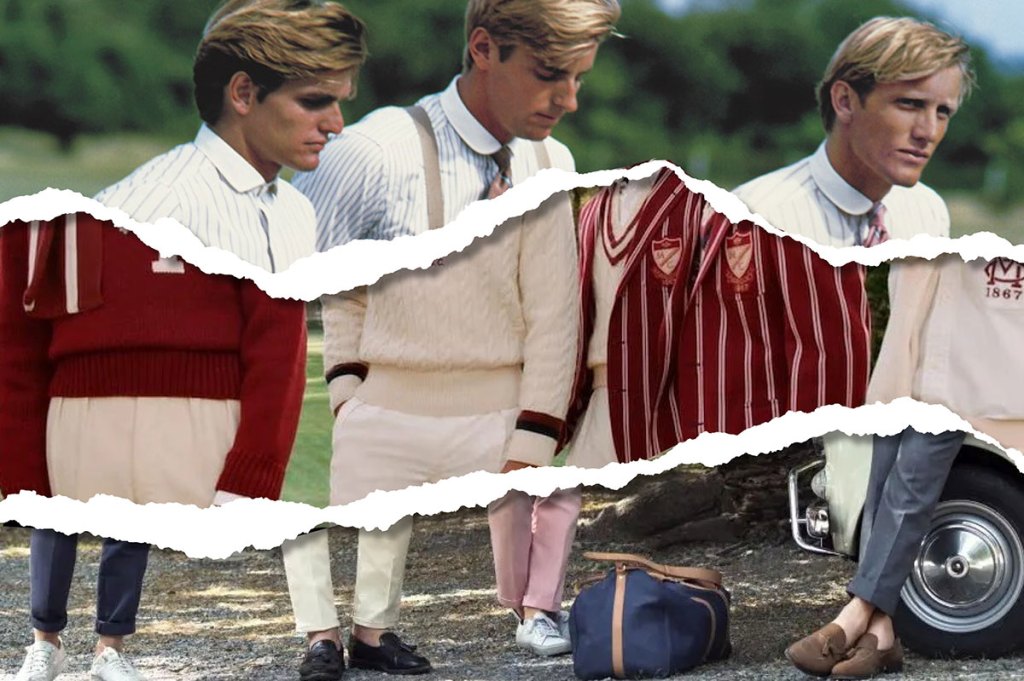Open up any social media and type in the word “prep.” I just did it: to my horror, I was met by a soft-voiced, big-lipped TikTokker dressing herself in bright, monogrammed clothes and topping the look off with a Tommy Hilfiger bucket hat and matching socks. I then called my friend Peter York, co-author of The Official Sloane Ranger Handbook, otherwise known as Britain’s answer to The Official Preppy Handbook and the Ten Commandments for an entire generation of preppy dressers in the United Kingdom.
“Prep is minimal,” he reassured me. “That’s the whole point, preppy clothes are a staple in everybody’s wardrobe.” But, as York told me, the younger generations’ take on this timeless trend “doesn’t sound remotely like what prep actually is.” He added that he felt like he was missing out on a new trend, and that he was going to download TikTok to investigate for himself. I said he needn’t bother — not least because this new take on “prep” goes against every rule in York’s book.
Over the last few months multiple articles have reported the resurgence of preppy dressing. I read a piece last week that claimed that “prep is back.” There’s a problem with that thesis: prep never left. It’s one of the only trends I can think of that has survived multiple eras largely unscathed. Wherever you stand on the aesthetic, it is as ever-present in fashion as a man’s suit. The prep boom in the 1990s succeeded the big hair and shoulder pads that dominated the Eighties, spearheading a movement of minimalism, and it never really went away. Slip dresses, clean-cut jeans, basic makeup and straight hair followed on from the prep boom. York summarized prep’s fluctuating appeal neatly: “It expands and contracts but it’s always there. Prep is ingrained into our history.”
What is being referred to as the “prep comeback” isn’t really prep at all. The TikTokkers call it an “old money aesthetic.” But, as anybody who knows anybody with old money will know, the influencers’ embrace of Chanel logo belts and Gucci-monogrammed blazers is hardly representative of what upper-crust types with inherited wealth actually wear. And it certainly isn’t prep. The posh people I know have to be convinced to buy a new pair of shorts because the ones they’re wearing have “only lasted ten years.” Jacob Rees-Mogg, an MP and almost self-parodic posh Brit famously wears one suit. When I asked him recently if he owned a T-shirt he replied: “Why on Earth would I do that?”
Maggie Bullock, the author of The Kingdom of Prep: The Inside Story of the Rise and (Near) Fall of J.Crew has a theory for why the younger generation are turning to what they think of as prep. “There is something deeply comforting about a return to the familiar,” she tells me. “And perhaps in an era of uncertainty, young people are craving a look that implies they are… upwardly mobile, successful.” Of prep’s enduring appeal she says: “It’s as reliable as death and taxes, and designers have been reinventing and deconstructing and reconstituting it since time immemorial. You can make prep sexy; ironic, purist, over the top or monastic and minimalist. It’s elastic, but worn in a classic way, it always makes you look kind of rich — or like you would very much like to be rich.”
It took nearly fifty years after their invention for light bulbs to become a standard feature in American homes, and even then only about half of homes used them. Something similar happened with prep. The clothes we think of as preppy today — cashmere, cardigans, tweed, trenches, loafers, polos and pullovers — first started to be worn in the late 1890s, mainly by wealthy men who went to Ivy League schools, hence the name. But the real boom in preppy fashion took place exactly forty years ago.
In January 1983, the first J. Crew catalog was mailed out. Its founders, Mitchell Cinader and Saul Charles, who started the company under the name Popular Merchandise in 1947 likely had no idea that they were on the cusp of changing American fashion forever. Their lightbulb moment was realizing that everybody wanted the upper-middle class Ralph Lauren look, but not everybody could afford it. They decided to corner the vast market in Americans who wanted a high-end look for a low-end price. Popular Merchandise sounds like a company that sells cheap clothes to middle-aged women, which it did. In an effort to appeal to their target audience, to sound “preppy,” Popular Club became J. Crew.
And it worked. Within a few years in 1989 the first J. Crew store opened in Manhattan, a risky move for a catalog at the time. But it would be a decade later in the late Nineties and early Aughts that J. Crew would become a truly inescapable part of the American fashion landscape. Like any good brand, J. Crew sold more than clothes. Everybody wanted to live like the models in their catalogs: young and gorgeous and having heaps of fun. From house parties with old friends to bike rides to walks along the beach or snow days with the family or even just moving house, J. Crew made every part of life look beautiful.
Bullock writes about the J. Crew catalog epitomizing, “the delicate brine of a clambake wafting in the air; the particular romance of a misty morning at a rustic lakehouse.” By mass-marketing social aspiration, a glimpse into a different world, J. Crew allowed an entire section of the population to slip into the higher ranks unnoticed. It was class camouflage, and all it took was a pair of loafers and a quarter zip.
Aspiration is synonymous with prep. For evidence, look no further than the story of Ralph Lifshitz, a Jew who grew up in the Bronx. After serving in the army, he got a job at a Brooks Brothers store as a sales assistant and soon set his sights on making clothes that encapsulated the “classic American dream.” After taking out a loan of $50,000, the man who by that point had changed his name to Ralph Lauren, founded his own brand, which he called “Polo Fashion.”
Although preppy style originated in around 1896 with Brooks Brothers, the terminology wouldn’t be used for another sixty years. There are squabbles about its invention — Harvard or Yale — but it was one of the two. An article in the December 17, 1962, Sports Illustrated, about the Yale-Harvard football game weekend, explained the collegiate slang:
Each house, like Harvard itself, is stereotyped. Eliot House, for example, is “preppie,” with an admixture of “jocks.” Preppie and jock are two of the sociological pigeonholes into which Harvard students are forever thrusting one another. Preppies are prep-school graduates.… Jocks are athletes… There are “wonks.” A wonk, sometimes called a “turkey” or a “lunch,” roughly corresponds to the “meatball” of a decade ago.
Within a decade, the word “preppy” would become almost as commonplace as “hippie.” In 1970 the book and film Love Story came out. It features a working-class Radcliffe student who calls her Harvard love interest “preppy” to tease him. Ten years on, in 1980, The Official Preppy Handbook by Lisa Birnbach came out. It was a satirical guide to the codes of high society, but the joke went over a lot of people’s heads and forty-three years later Burnbach’s handbook is still the authoritative guide to preppy fashion. A copy of the book will cost you anywhere from $300-$1,000. My TikTok is full of twentysomething influencers scrambling for them.
Maggie Bullock tells me that the book came at a turning point: “America was dragging itself out of a brutal recession; Ronald Reagan was elected in 1981 and even though what actually happened economically was more complicated than we tend to remember, he was a symbol of a new age of prosperity and also an era of conspicuous consumption: After the blue jeans populism and the transgressive rule-breaking of the bellbottom Seventies, suddenly it was OK again to wear your social and fiscal aspirations on your sleeve, literally. One interesting thing about prep is that it is the uniform of the establishment — and yet most of its basic components are practical, widely available, and affordable, durable, and easy to wear and understand. There’s very little barrier to entry (until, you know, the loafers are Gucci, and the watch costs $30,000). Which makes it a perfect vehicle for the aspirant.”
Across the pond the prep movement was also happening in another form — only the Brits called them Sloanes, short for “Sloane Ranger,” after the affluent Sloane Square neighborhood of London. Barbour jackets, ballet pumps, and a silk headscarf — preferably Hermès or Liberty. Sloanes were tribal, and this was their uniform. York describes the key difference between prep and Sloane: “Prep is very university based, it was born from the college campus. Sloane was something that was cradle-to-grave.”
So what is happening to prep now? Why all the bucket hats and gaudy labels? An entire generation of social media influencers are claiming to be “bringing prep back,” without understanding the fundamentals of the style. York calls it the “fashionization” of prep and claims that this was done by the very same people that invented it, or at least brought it to the mainstream. “J. Crew was a stalwart of the prep trade back in the day, but what happened was it suddenly got fashionized at some point early this century.” Of a recent trip to preppy stores in New York he says that “it looked like someone had swallowed the Great Gatsby whole.”
Prep expands and contracts — but it is always there. Whether or not the TikTokkers truly understand prep, its enduring appeal is beyond doubt. After some apocalyptic nightmare all but wipes out humankind to its knees, the survivors will probably find a a cable-knit sweater peeping out from under the rubble — and prep will prevail.

















